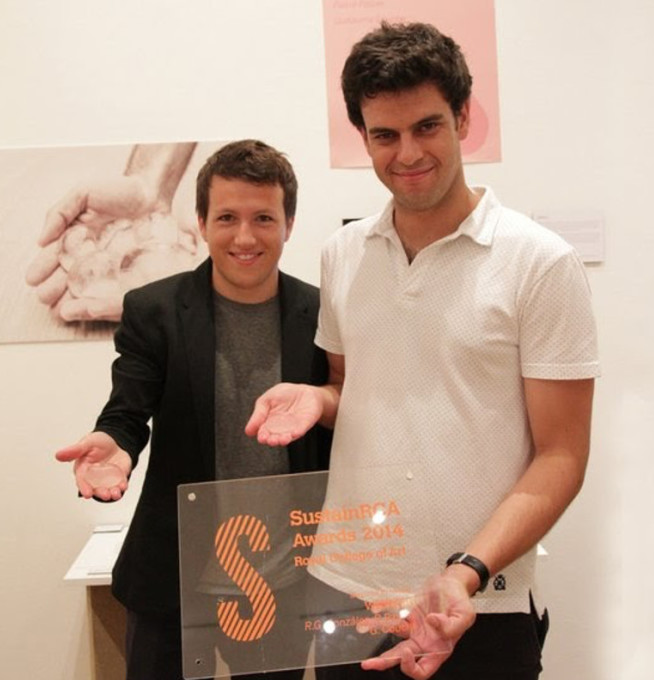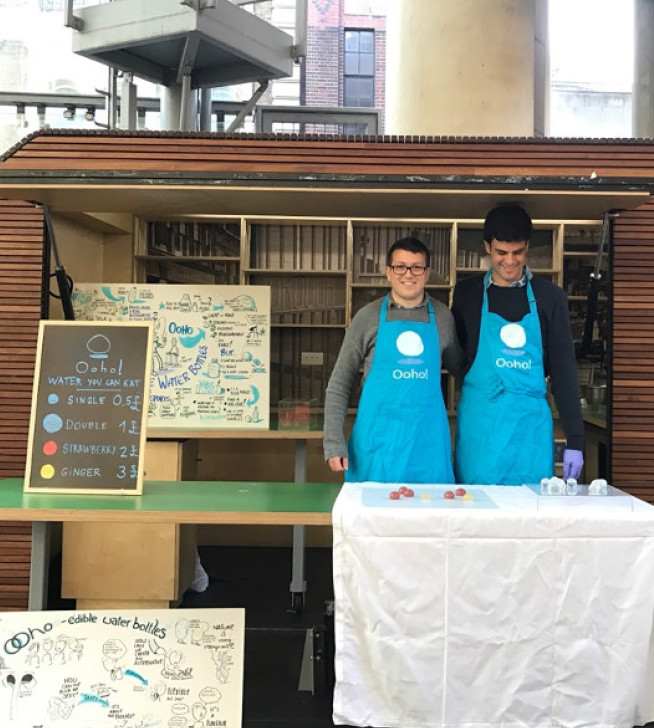Pierre Paslier and Rodrigo García González

Pierre Paslier and Rodrigo García González studied Innovation Design Engineering, graduating with an MSc in 2014, during which time they co-founded the sustainable start-up Notpla. Head to Notpla's website to find out more about the company.
The MSc/MA Innovation Design Engineering programme is jointly run by Imperial and the Royal College of Art - read more about the course.
Notpla was featured in Issue 48 of Imperial Magazine, as part of a feature on alumni innovations in the 'plastic revolution' - you can read the article here.
In 2021, Pierre and Rodrigo launched the Notpla Box, the latest product in their commitment to reducing plastic waste. Find out more about the sustainable take-away Notpla Box.
We spoke to Pierre and Rodrigo about their time at Imperial and their entrepreneurial journey.
Can you tell us about your studies at Imperial?
Rodrigo: Through my background in architecture before studying at Imperial, I developed an early interest in plastic waste and the ways we can use and reuse plastics to create brand new ideas. As far back as my undergraduate days, I used plastic bottles and bags to create vacuum formed sculptures, heated plastic bags to form toys, and used chewing gum to create furniture. Solutions to and for waste had always been a big part of my projects. After my architecture degree, I went on to study industrial design in Sweden. I learnt that smaller-scale ideas can often have a bigger impact, as they are easier to replicate than those found in architecture. You can have a more positive impact by starting small. This led me to London, and Imperial College’s joint Innovation Design Master's degree with the Royal College of Art.
Pierre: Much like Rodrigo, plastic and packaging was already a firm feature in my work. Having studied engineering in France, I went on to work as a packaging engineer for L’Oreal in Paris. Here I learnt so much about the industrialisation of packaging production and the shocking pace at which one industry could generate plastic waste. One project which made me realise the extent of the problem, and our reliance on plastic, was the redesign of face cream jars from glass to plastic. To replicate the expensive look and feel of glass, the marketing teams decided to use more plastic, making a thick plastic jar that felt like glass for the premium feel. The choice would lead to 30 tonnes of extra plastic being used in production each year. This excessive use of plastic and lack of awareness made me want to become part of the alternative, finding ideas that are more innovative and positive, not creators of more problems. This led me to the same Master's course as Rodrigo that year.
Our course was all about following our own briefs, working on things we were passionate about, and coming up with new ways of solving problems - there was no strict curriculum. The main thing we learnt at Imperial was how to get access to all departments. Innovation Design Engineering is a unique Master's with a very diverse group of students. There was lots of peer learning and fast-paced innovation, with a good balance of making and thinking.
What is your fondest memory of your time here?
Pierre: Late night prototype-making in the Ideas Lab, the Design Engineering Society’s student-run makerspace.
Find out more about the Ideas Lab.
What is your favourite place at Imperial and why?
Pierre: The Alumni Visitor Centre – there are free drinks!
Can you tell us a bit about the start-up you are working on?
Rodrigo: During my Master's, I was working on a project which studied how clouds deliver water. I was curious about how humans could transport water through the air in a similar way. Through our own artificial clouds, how could we deliver water to people without using plastic? In our early designs you can really start to see our thinking behind our product. Answering the impossible questions was part of our ethos from the get-go.
Our key inspiration was looking at natural containers of water, such as fruit and eggs. This led to other food experiments, and we ended up looking at the potential of seaweed in creating artificial fruits. We started with the idea of fruit being a form of packaging that occurs in nature, like an orange peel - the perfect natural container. Mirroring this, we used edible ingredients to build our own, taking the concept to the extreme.
Our first prototypes of what we now call Ooho were developed in our kitchens with as many of the ingredients as we could find online. We released a video of our “cook it yourself” process under Creative Commons, an open source framework. As a result of this, our idea began to snowball on social media, with one Business Insider video gaining 20 million views.
Natural packaging has been done before, but no one had made it edible. In our eyes, being edible proved that the concept was 100% safe and 100% waste-free. This edible element really captured people's attention, but we didn’t think of the project as a business at first. The early prototypes were fragile (and far from practical) and we were both ready to wrap it up at this point and move on to the next innovation. However, the amazing reaction from our video and the uniqueness of the product really made us think we were onto something - so we kept going.
Watch the Business Insider video on Ooho here.
Around the same time, we won a start-up grant from the Climate KIC incubator, despite not yet being a company. We were also receiving calls with offers to buy shares in the business, so we thought we should probably set one up. The next challenge was to name the product and the company. Both came quite easily: ‘Ooho’ was the sound of surprise most people had when trying one for the first time, so Ooho it was! We named the company ‘Skipping Rocks’ after a trip to New Zealand skimming stones. We liked the idea of making rocks fly - it mirrored what we were trying to achieve with Ooho, doing the impossible. And everyone was starting labs in 2014, so Skipping Rocks Lab was born! (Now known as Notpla)
Head to the Imperial Enterprise Lab’s profile of Skipping Rocks Lab.
After we underwent a rebrand, the company is now known as Notpla: Not PLA, Not Plastic, a simple way of representing what we are striving for.
How has Imperial helped you in your career so far?
Both: Imperial has helped lots. For the first two years of our start-up, through Imperial Innovations, we benefitted from masterclasses on marketing, recruitment, fundraising and financial modelling, as well as access to mentors and IP help.

Once our Master's were wrapped up, we won the support of the Imperial College incubator, working in the White City iHub to develop Ooho. We set about streamlining our processes and optimizing the properties of the membrane. We continued to work from the South Kensington Campus Chemistry Labs: with the help of some enthusiastic first-year Chemistry students, we were making membranes, adapting the recipes as we went. We gave them away at festivals, markets, and other events in London and across the world, including the first of many marathons to come! We learnt a lot from people’s reactions. At this point, despite our name (Skipping Rocks Lab), we didn't have a lab.
DIY is the best way to describe Ooho in the early days. No one was earning a salary from the project. Rodrigo was teaching whilst Pierre was working for a different start up, Gravity Sketch (another innovative start-up funded by Imperial alumni – read more about it in this Imperial news story). We spent a lot of time at Imperial twisting the arms of PhD students to spend a few hours of their time helping us develop our products, and coming up with assignments for the Business School students to help us study the market. Our time spent hustling for free resources earned us the title ‘Parasites of Imperial’!
When we were able to start recruiting our own team, we also spoke to members of the Imperial Innovations team to benchmark salaries and compensation. Now we are a team of 27!
What have been your career highlights and lowlights?
Both: Our deal with Selfridges was a real game changer for us; it was our first experience with a big label with high standards, so we learnt to up ours quickly. Everything was going smoothly, until the real challenge arrived the week before launch. Naturally, as we were quickly learning, machines like to break, right on cue, and the week of production they did exactly that. The new part wouldn’t arrive until that Saturday morning, and we were to start selling at 9am on Monday. All bad things happen in threes, so our office’s street’s sewage system became blocked and flooded the downstairs production space. We spent the weekend bleaching the entire office. Monday came with half the batch produced, so to top up throughout the week we dropped off bags of Oohos at the doors of the store. This really was a learning curve which we thank Selfridges for: it was a great study in selling and scaling up the production of Ooho.
Read more about Selfridges' partnership with Ooho.
Due to lockdown, we have had to make huge adjustments this year in terms of the ways we work - production teams have been relocated to new projects, to occupy the periods where demands for our products at events have been very low. We’ve been very lucky during these lockdowns to have been awarded a number of innovative UK grants to help us industrialise and maintain our Research and Development programme.
What are your plans for the future?
Pierre: To make packaging disappear.
What would your advice be for current students who are budding entrepreneurs?
Pierre: Don’t wait to have a perfect plan to start raising funds.
What makes you proud to be Imperial alumni?
Pierre: The global impact of Imperial alumni on so many fields of science and technology.
What one word or phrase would you use to describe Imperial alumni?
Pierre: Ready.
Do you have a favourite quote or saying?
Pierre: The pace of change has never been this fast, yet it will never be this slow again.


